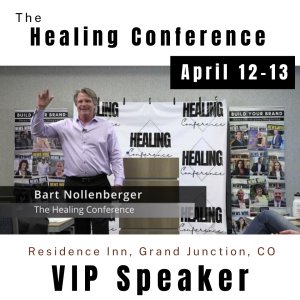Jon Macaskill Speaking at The Healing Conference in Colorado Springs
Ladies and Gentlemen, please put your hands together for Jon Macaskill. Alright, thank you so much. I don’t know how to set this clock, but I have a clock on my phone here, so I’m just going to go by that. I want you to imagine that it’s 2:15 a.m., and you’re getting woken up. This was a scenario I was in as a first-time father: 2:15 a.m., three weeks into my first-time fatherhood. And I’m embarrassed to admit that I was a little frustrated that I was getting up at 3:00 a.m., 2:15 a.m., and 3:30 a.m. the next night to feed my 3-week-old daughter, doing what a 3-week-old daughter does, crying when she’s hungry. And I would go through, and I would warm up the bottle, and I would be feeding her. And while I’m holding this beautiful little miracle in my hands, what I’m thinking about is the next day at work, and what I had to do at work, or the day before at work, and what I had screwed up. And now, I work myself into this frenzy, and I take this beautiful little miracle, put her back in the crib, and go back to bed, but I don’t go back to sleep because I’m stewing. Then fast forward two months, and I’ve been practicing mindfulness and meditation, and I hear my girl, my little girl cry, and I’m excited like, yes, this is an opportunity for me to go and spend some time with her alone when the world is quiet. And I go through, and I warm up the bottle, and I go through to her, pull her out of the crib, put her in my arms, and pay attention to the little noises she’s making. And I pay attention to her reaching up with her tiny little fingers and grabbing my thumbs and my fingers, and the little noises that she’s making, right? And then, when I’m done feeding her, I spend a little extra time with her, put her down in her crib, and go back to bed. And what happens? I go back to sleep because I have not worked myself into that frenzy, and that’s what mindfulness and meditation have done for me.
Now, that all said, I want you guys to stand up real quick. I want you to find somebody in the room and pair up with them, and I want you to turn to them and say one nice thing about them. One nice thing. Hey Mac, you don’t get out of this. Find somebody. You can pair up and make a trio right here. We’ll have a three-way there. You go. Alright, don’t go sit down, don’t go anywhere. Alright, now what I want you to do is turn to that same person. I want you to tell them one nice thing, one more nice thing, but this time, here’s the catch: I want you to make it about yourself. Yep, that’s normally the response I get: total silence, total fear. And I know Tracy just walked us through that tapping and relaxed us, and now I’m amping you guys up. Don’t worry; we’ll bring you back down—one nice thing about yourself. You got great accents, you can… what a great accent you both have. Somebody from the country, you’re right, buddy; I don’t know what I was thinking. So awesome. Alright, when you’re done with that, go ahead and return back to your seats.
Now, much like Tracy just did and had you do an inventory of how you felt in your body, mind, and nervous system before we did the EFT, I want you to take a snapshot, an internal selfie, if you will. Take a snapshot; imagine taking a phone and taking a snapshot of yourself, in your body, in your mind, and in your nervous system, how you feel in all three of those, okay, after saying something nice about the person that you know better than anybody on the planet: yourself. You may feel a little anxious. I know when I go to church on Sunday, and the pastor says I want you to stand up and say hello to the person next to you, that’s my least favorite part of my week, right? And I love church, I love church, but I hate that because I like, Kathy, funny enough, I’m a speaker, but I’m an introvert, and I cannot stand just saying something to saying something, like hello, to the person next to me. So, I ramped you up for a reason because now I’m going to bring you back down. Alright, so I want you to close your eyes if you’re comfortable doing so, and I want you to do nothing else besides focus your attention on your breath. You don’t have to force it; you don’t have to count. I want you to notice the physical attributes of your inhalation and exhalation. Intentionally pay attention to the rise and fall of your belly and chest as you inhale and as you exhale, and notice how that air feels as you exhale, maybe slightly cooler, versus how it feels as you exhale, maybe slightly warmer. And notice where it is entering your body. Maybe as you inhale, it might be coming through your nostrils. Maybe notice and pay attention to the tips of your nostrils as you breathe in and out. If you’re breathing out through your mouth, maybe notice the air passing out past your lips. A couple more inhale and exhale. Now go ahead and open your eyes; come back into this space. How do you feel now? That internal selfie may be slightly different. I heard a yawn. That’s not a bad thing; it’s a good thing.
Alright, so what I did there was talk about the nervous system. Uh, Tracy, I heard you talking about that before, and Kathy, I know you referenced it before. There’s a lot of overlap between what you two speak about and what I speak about. The nervous system is broken down into the autonomic nervous system, the parasympathetic nervous system, and the sympathetic nervous system. The amygdala controls the sympathetic nervous system. That is what’s there for the fight, flight, or freeze: to defend us from that saber-toothed tiger, right? When we were cavemen and women back in the day, when we go out, yes, it’s great to assume that if I go around this corner, to assume that there’s a saber-tooth tiger there and be wrong, not a problem. But if I assume the reverse, if I go around this corner and assume that there’s no saber-tooth tiger, and I go around this corner and, oh, there is one, that’s the end of me and probably the end of humanity, right? Well, that’s there to defend us, to defend us and humanity at large. Now, the other side of the nervous system, the parasympathetic side, that’s what calms us down. So, when I had you guys introduce yourselves and say something nice about the other person, and then say something nice to them about yourself, your amygdala kicked in, your sympathetic system ramped up, and you got anxious. Then I had you breathe, and your parasympathetic nervous system kicked in, and you calmed back down. So, that’s why I did that. The other reason I do it is because I get nervous right in front of a crowd, allowing me to calm myself down right before my eyes.
Now, here’s a little background about me. Bobby touched on it. Uh, I grew up in South Africa, actually. I was born in Cape Town, South Africa, and moved to the States when I was seven. My parents left South Africa in 1984 to bring my siblings and me, specifically my younger brother and me, over to the States to get away from the military draft. And then, I voluntarily enlisted in the Navy after going through high school in Rustin, Louisiana. Enlisted in the Navy, got picked up from the enlisted ranks, went to the Naval Academy, graduated in 2001, and went into Navy SEAL training, Basic Underwater Demolition SEAL training, BUD/S. That’s a six-month program out in sunny Coronado, California, a beautiful spot outside the Hotel Del Coronado. But somehow, the instructors still find a way to make it a living hell. But anyhow, fast forward, I served my 17 years after that in the SEAL Teams or Special Operations in some capacity. And now I do what I love, a lot of Navy SEALs do, and that is public speaking. But I speak on something slightly different than what most Navy SEALs speak on, and that’s this hippie-dippy, woo-woo meditation and mindfulness stuff. So, the question always comes up like: how did you go from being a special operator into teaching mindfulness and meditation?
So, in 2005, I was involved in an operation that went horribly wrong, and we ended up losing 19 men. And I was actually not on the battlefield for that. I wanted to be on the battlefield. I was on the radio, and I was on the phones, and I was on the computer, and I heard all this happening. And where was I? I was sitting behind a desk. And I returned from that deployment with a lot of moral injury survivor’s guilt; why
them and not me? Why me and not them?” Those types of things. And I carried that with me, and I self-medicated with alcohol and prescription medication for years. And I got to a point where I actually considered some very dark options. And I went and saw this counselor. I went and saw this counselor, and this counselor sat across the table from me. He says, “I want you to try something. I want you to try mindfulness and meditation for me.” And I laughed at him. I said, “Doc, I’ve got some real stuff going on like I need some medicine. I need medication, not meditation.” And he says, “Okay, well, what if I had a pill that I could give to you that would change the way that you perform? Change the way that you perform physically and mentally, personally and professionally?” And as a Navy SEAL, special operator, and military member, you’re always looking for an edge. You’re looking for an edge over your enemy on the battlefield, or you’re looking for an edge over your buddy right next to you. You’re looking for an edge. So, heck yeah, Doc, whatever that pill is, give it to me. Well, it wasn’t a pill, as you can imagine. It’s meditation. So, he kind of tricked me. I’m like, “Okay, got you, Doc. Now you’re speaking my language. I’m going to try this meditation.”
So, as a Type-A personality, the next day, I’m like, “You know what? I’m going to crush this meditation.” And I sit down for this hour-long meditation, day one. Alright, bring my attention to my breath, focusing on my breath, focusing on my breath. “I got to pay my taxes, I got to change the oil in my truck, I got to pick up my dog mess in the yard.” My mind was on anything except this meditation. So, I go back to this Doc, and I’m frustrated. Now, I’m like, “Doc, this meditation stuff, it’s exactly what I thought it was. It’s hippie-dippy woo-woo, it doesn’t work.” He says, “Well, what did you do?” And I tell him what I just told you. He says, “John, you can’t do that. That’s like lining up at the starting line of a marathon without ever running a step before or going into the weight room and getting under 350 lbs on the bench press without ever having lifted weights. I’ve never been able to bench press 350 lbs; I just put that out there.” But anyhow, now he’s speaking my language. I’m like, “Doc, what do I do?” He says, “I want you to stop, and I want you to breathe in for a count of four, hold for a count of four, breathe out for a count of four, and hold for a count of four.” And he says, “That’s called box breathing. You do it four or five times.” I’m like, “Doc, we do that on the shooting range. We do that before we go into what we call the kill house, which I know is kind of an ugly term, but that’s where you learn to clear a house anyhow. We do that; we just call it tactical breathing. We don’t call it meditation, we don’t call it mindfulness, we don’t call it breath work. It’s just tactical breathing.” But now I’ve done it. So, now I leave his office and get cut off by some jerk in traffic. I’m like, “Oh, maybe I should try this box breathing.” So, I try it out. “Alright, alright, it’s calming me down.” So then, later, something else happens, and it stresses me out, so I try the box breathing, and it calms me down. Then, I started to do it regularly, and then I started to do longer and more in-depth meditations. They started to calm me down, and they changed me.
And I think, Kath, you were talking about earlier, somebody came up to you, and they said something about how you were acting differently, right? Somebody came up to me, they put their arm around me at work, and they pulled me aside. They’re like, “John, what are you taking?” I’m like, “Actually, I’m not taking anything.” And now, there’s a little bit of fear and anxiety in me. I’m like, “I’m going to tell this guy that I’m meditating, and he’s going to, his eyes are going to kind of glaze over, he’s going to turn around, he’s going to walk away, and never talk to me again.” But what happens is, he’s like, “Oh, really? Tell me more about that.” So, I started telling him, and he actually started becoming a mindfulness practitioner, which changed him. Mindfulness and meditation changed my life for the better, and I’ve seen it change other people’s lives for the better. It quite literally saved my life. So, that’s why I now teach mindfulness and meditation. It is a duty and an obligation to pay it forward so that I can change and potentially even save other people’s lives. So, that’s how I got from being a special operator to doing what I’m doing now.
So, I say mindfulness and meditation; often, you hear those terms used synonymously. I personally do not believe they are the same. Mindfulness is a way of living. I’m a math major. Do you guys remember Venn diagrams, the circles? So, you got one circle over here with something in it, another circle over here, and then when they intersect and unions and all that stuff, yeah, okay. Mindfulness is in this circle. Mindfulness is a way of living. It’s a way of being. It’s being present in the here and now, paying attention to what you’re experiencing physically and emotionally, without any judgment. That last piece is key because many of us judge ourselves for the feelings and emotions we experience without judgment. Meditation is in the other circle. That’s a formal practice where you practice this focus on an anchor of some kind. That could be your breath, a mantra, or a body scan, which we’re going to run through here shortly. Maybe not, because we don’t really have time. So, that’s the meditation. Then, the two overlap in mindfulness meditation. And you can practice and live mindfully, and that’s going to improve your meditation practice, and you can practice meditation, and that’s going to improve your living mindfully. They complement one another.
Alright, so the science behind it, what’s actually happening? Because Tracy was talking about people needing to see the data, right? I started practicing, and I went back to that doctor. I’m like, “Hey, man, what’s actually happening here? Like, why does this work?” He said, “Well, when you sit down, and you start to think about your taxes and changing the oil in your truck and everything else, and then you bring yourself back, and you bring yourself back, and you bring yourself back, over and over and over, that’s actually where the magic happens. It’s like doing a mental push-up of some sort. You’re strengthening your focus muscle and the lining between the amygdala and the prefrontal cortex. And the prefrontal cortex is the part of your brain responsible for rational thought. You’re also tapping into that parasympathetic side of your nervous system, calming yourself down. So, that’s what’s happening. You’re learning to focus, and you’re learning to calm your body, your mind, and your nervous system down.”
I often get the question, “Well, I’m too busy. I wake up at 5:00 a.m., and I’m running and gunning until midnight. I just don’t have time to squeeze something else into my day. How am I supposed to meditate?” I guarantee you that many of us waste a lot of time on these phones, right? We wake up with them, use them as our alarm clocks, and after hitting snooze two or three times, then roll over. What do we do? We check social media, we check our emails, we check the news, we check everything. And now we’ve burned up 20, 25 minutes before we’ve even gotten out of bed. You have time. Now, if you are just maxed out in your day, maybe you may not have time for meditation, like 15, 20, or 60 minutes. But maybe you can do a mindful minute here and there. As you’re driving to work, 2 to 3 minutes before you’re done driving, turn off the radio and tune in to the physical sensations that you’re experiencing. Pay attention to the steering wheel in your hand, pay attention to the seat against your back and against your butt, and pay attention to the sounds of the wheels rolling. Take a few breaths. When you pull into that parking lot and get out of your vehicle, you’re going to feel completely different than you did the day before. Then, do it in reverse on your way home. You can leave work at work when you get home so that you can be more present. And guess what that is? That’s mindfulness, right? So, you can do it in different ways. You can have a mindful meal. So many of us these days sit behind a computer, and we wolf down our burgers and fries while we’re working in front of a computer, while we
have the TV on in the background, and while we’re on the phone. That’s the exact opposite of mindfulness. Put your phone down, turn the TV off, and step away from the computer. Go have a mindful meal, paying attention to the meal in front of you, expressing gratitude for that meal in front of you because it didn’t just conjure up on that plate. It did not. People helped to get it there. Spirit, some type of spirit — I don’t know your guys’ religious beliefs — helped to get it there, right? We have to express that gratitude.
So, that’s how and when we can do it, even in our busy days. That said, I want to run you guys through a quick meditation. Tracy helped calm you down with the tapping. Now, I’m going to help calm you down with meditation, and this is just going to look like a quick body scan. Okay, so I invite you to, if you’re comfortable — and I will preface this too, I know a lot of us do have our own spiritual and faith beliefs, this is not here to change that in any shape, form, or fashion. Whatever your spiritual beliefs or religious beliefs are, this is completely secular. This is just going to be focused on a body scan from the head down to the toe and back up, quick, nice, and simple. But if you are uncomfortable for any reason, then I invite you just to sit there. You don’t have to follow along at all. You can just sit there and experience mindfulness in a separate way.
Alright, so go ahead and get comfortable, whatever that looks like for you, and if closing your eyes feels comfortable, then I invite you to do so. Otherwise, just soften your eyelids, soften your gaze, and let’s bring your attention to the very crown of your head, noticing the physical sensations in the crown of your head and the crown of your head only and and scanning down into your forehead, your temples, your eyeballs, your jaw, noticing the physical sensations in your jaw. I do not feel the need to necessarily change anything, but I am just aware of them. Scanning down into your neck and throat, your shoulders, and from your shoulders, shoot out to the tips of your fingers, noticing the physical sensation in the tips of each of your fingers and scanning back into your hand, front and back, your wrists, elbows, your upper arms, and into your shoulders again.
Scanning from your shoulders down into your chest and upper back, upper abdomen and middle back, lower abdomen, and lower back. Continue focusing on the physical sensations, scanning down into your pelvic bowl, your thighs, front and back, knees, shins and calves, your ankles, noticing the physical sensation in your heels. Scanning forward, moving forward to the balls of your feet and each toe, all the way to the tips of your toes. And now, scanning quickly all at once, from your toes to the balls of your feet, the heels, ankles, calves, shins, knees, thighs, front and back, pelvic bowl, lower back and lower abdomen, middle back, middle abdomen, chest and upper back, shoulders shooting out to your fingertips and scanning back from your fingertips into your whole hand, front and back, wrists, forearms, elbows, upper arms, shoulders, neck, jaw, eyeballs, your temples, and to the crown of your head again.
And we’ll conclude with one deep, cleansing breath together. Begin by exhaling all the way, emptying your lungs, and holding empty at the bottom. Nice deep breath in through your nose, starting with your belly into your chest. Hold at the top, and let that out with a nice sigh. And as you do, wiggle your fingers, bring some movement back into your body, and that, ladies and gentlemen, is a quick body scan. Now, how does that feel? Amazing? Feel good? Did nobody fall asleep? Alright, well, that is mindfulness and meditation for you.
And uh, I will conclude by letting you know, if uh, if you’re here today, and you text the word “mindful,” M-I-N-D-F-U-L (not double L, sorry, just one L) to 33777, that’s 33777, you’ll get added to my weekly mailing list, which has mindful tips, mindful resources. It includes links to my podcast, “Men Talking Mindfulness,” and will also give you a link to purchase my short book, 65 pages, quick, easy read. You can sit down and read in one sitting. So, that’s “mindful” to 33777. And that, ladies and gentlemen, is all I have to say about that. Thank you so much. Appreciate it. One more time, everybody. Thank you.





